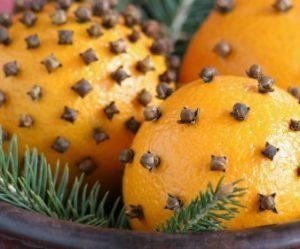I have always loved the look and smell of these wonderful holiday decorating treats! I must admit I've never taken pictures of mine, but maybe I will this year. In the mean time, the picture below was just too pretty not to show. I have to say I've never seen them done so beautifully! I'd always read that you just "poke the cloves in all over the orange". Nothing was ever said about making pretty designs!
So to get us started, how about some inspiration!
Ooooo! Lemons too!
How about a face for that pomander? Fun & cute!
Beautiful!
WOW!
Before we get started with how to make them, how about a bit of history about them? I'm a bit of a history and "origins" freak. I like to know when something happened as well as why. So here's a bit of info for you:
The word "pomander" is derived from the French pomme d'ambre, meaning "apple of amber". This pomme d'ambre is a ball made from perfume materials such as ambergris (whence the name), musk, or civet. These ingredients were placed into a perforated gold or silver vessel that was hung by a chain around the neck or the waist. One particular formula from 1584 included storax, calamite, labdanum and benzoin resin. These ingredients were powdered, combined together and dissolved in rose water, then cooked down to a paste. This was then molded into an apple shape and rolled in powdered & blended-together cinnamon, sweet sanders, and cloves. After this, several grains of ambergris, deer musk, and civet musk were dissolved in a small amount of rose water. The "apple" (pomme) ball was then rolled in this mixture, blending these ingredients with the first, kneading them altogether. Once they were well combined the pomme was re-formed. This "apple" was then carried in a vessel on the body or placed in a bowl in the home, its scent perfuming the air.
Pomanders were used mainly as protection from disease as well as to counter bad odors.
The word "pomander" is derived from the French pomme d'ambre, meaning "apple of amber". This pomme d'ambre is a ball made from perfume materials such as ambergris (whence the name), musk, or civet. These ingredients were placed into a perforated gold or silver vessel that was hung by a chain around the neck or the waist. One particular formula from 1584 included storax, calamite, labdanum and benzoin resin. These ingredients were powdered, combined together and dissolved in rose water, then cooked down to a paste. This was then molded into an apple shape and rolled in powdered & blended-together cinnamon, sweet sanders, and cloves. After this, several grains of ambergris, deer musk, and civet musk were dissolved in a small amount of rose water. The "apple" (pomme) ball was then rolled in this mixture, blending these ingredients with the first, kneading them altogether. Once they were well combined the pomme was re-formed. This "apple" was then carried in a vessel on the body or placed in a bowl in the home, its scent perfuming the air.
Pomanders were used mainly as protection from disease as well as to counter bad odors.
Nostradamus also had his own formula for making pomanders!
Nostradamus' method and formula was just about the same as listed above, but with a few differences. His method for making pomanders was to make "rose tablets" by gathering a pound of rose petals and 7 ounces of ground benzoin. Soak the rose petals in deer musk water overnight. Then remove the rose petals, thoroughly squeezing out the water.
Nostradamus' method and formula was just about the same as listed above, but with a few differences. His method for making pomanders was to make "rose tablets" by gathering a pound of rose petals and 7 ounces of ground benzoin. Soak the rose petals in deer musk water overnight. Then remove the rose petals, thoroughly squeezing out the water.
Next, grind the petals with the powdered benzoin. While grinding, add a quarter of ambergris and another of civet musk. Once ground, you make compress into little tablets and put each one between two rose petals. Then you dry the tablets away from the sun.
The next step is to combine 2 ounces of the purest labdanum, 1 ounce each of Styrax calamites and benzoin, 1/2 ounce of the "rose tablets", 1 ounce of violet powder, and 1/2 dram each of ambergris and musk and grind everything into a powder.
Next, Nostradmus' instructions say to knead it together with the rose-mixture for an hour (or very thoroughly mixed, would be my suggestion) and when finished, you will have "an aromatic ball of the most supreme perfume, and the longest-lasting that can be made anywhere in the world".
*****
Ok, now that we've got some visual and historical inspiration going here, how about some instructions!
How to Make a Pomander Ball
This recipe is a large one so you can coat quite a few oranges, and save the rest in the freezer for another time, if you want.
Needed Materials
Needed Materials
Thin-skinned Oranges (how ever many you plan to make)
6 cups Cloves -whole
2 cups Cinnamon powder
4 cups Orris Root powder
1 1/2 cup Allspice powder
1 cup Ground Nutmeg
1 cup Ground Coriander
2 cups Ground Orris Root (preservative)
Toothpick, Skewer or Large Needle (to poke holes in orange)
2 cups Cinnamon powder
4 cups Orris Root powder
1 1/2 cup Allspice powder
1 cup Ground Nutmeg
1 cup Ground Coriander
2 cups Ground Orris Root (preservative)
Toothpick, Skewer or Large Needle (to poke holes in orange)
Electrical Tape (to keep rows straight, if needed)
Ribbon






No comments:
Post a Comment